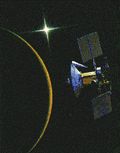|
|
|
Venus has been visited by several probes.
|
|
|
Venus Facts
-
1.
Venus is the second closest planet to the sun. |
-
2.
Venus is the closest planet to Earth. |
-
3.
A day on venus lasts longest than it's year. |
-
4.
Venus rotates in the opposite direction
of all the other planets. Looking down
from it's north pole it rotates clockwise.
The other planets rotate counter clockwise. |
-
5.
Venus is the brightest object in the sky besides the sun and moon.
In fact in very dark locations, venus has been known to cast shadows. |
-
6.
Venus has been called both the morning star and the evening start because
it is only seen near the sunrise and sunset. |
-
7.
Venus is the hottest planet in the solar system. |
-
8.
The atmosphere atmosphere contains 96% carbon dioxide (a greenhouse gas),
and 4% nitrogen which contributes to the high temperature. |
-
9.
The atmosphere atmosphere contains 96% carbon dioxide (a greenhouse gas),
and 4% nitrogen which contributes to the high temperature. |
-
10.
The atmosphere atmosphere contains 96% carbon dioxide (a greenhouse gas),
and 4% nitrogen which contributes to the high temperature. |
-
11.
The atmosphere atmosphere contains 96% carbon dioxide (a greenhouse gas),
and 4% nitrogen which contributes to the high temperature. |
|
| |
|
 |
Venus Express is ESA's first mission to Earth's nearest planetary neighbor, Venus. The mission was born after ESA asked for proposals, in March 2001, suggesting how to reuse the design of the Mars Express spacecraft. After a 153 day cruise to Venus the spacecraft entered Venusian orbit on 11 April 2006. |
| |
|
 |
Pioneer Venus consisted of two spacecraft to study Venus: the Orbiter and the Multiprobe. The latter separated into 5 separate vehicles near Venus. The Orbiter was launched on the 20 May 1978 from the Kennedy Space Center aboard an Atlas-Centaur rocket. It went into orbit around Venus on 4 December 1978. Its primary objective was to investigate the solar wind in the Venusian environment, map Venus' surface through a radar imaging system, and study the characteristics of the upper atmosphere and ionosphere. The Orbiter carried twelve instruments, most of them dedicated to plasma investigations of the Venusian upper atmosphere, as well as instruments for observing reflected sunlight from the cloud layers at a variety of wavelengths, and a surface radar mapper. There was, however, a gamma-ray burst detector experiment added on the satellite. Although originally intended to operate in orbit for one Venusian year, most of the Orbiter instruments, including the gamma ray burst detector, were still operating when the spacecraft entered the atmosphere on 8 October 1992. |
| |
|
 |
NASA's Magellan spacecraft made a dramatic conclusion to its highly successful mission at Venus when it is commanded to plunge into the planet's dense atmosphere Tuesday, October 11, 1994. During its four years in orbit around Earth's sister planet, the spacecraft has radar-mapped 98 percent of the surface and collected high-resolution gravity data of Venus. The purpose of the crash landing is to gain data on the planet's atmosphere and on the performance of the spacecraft as it descends. |
| |
|
| |
|
| |
|
| |
|
| |
|
| |
|
| |
|
|